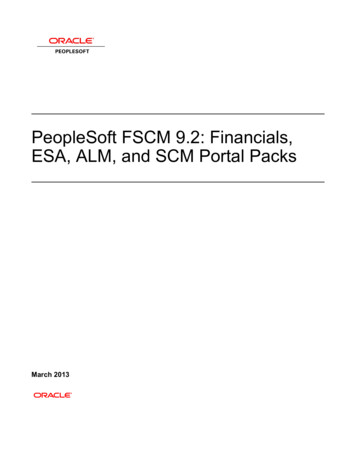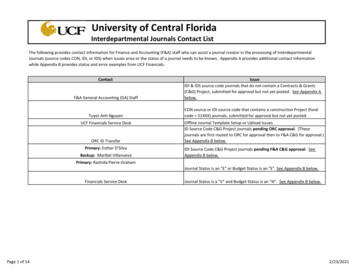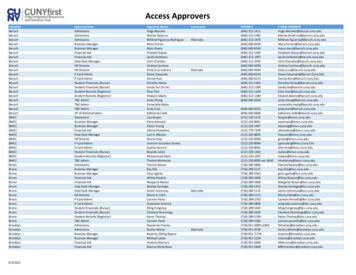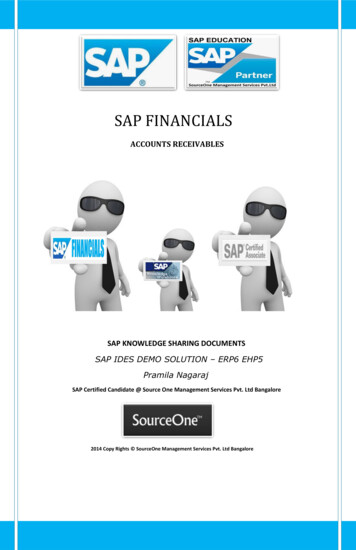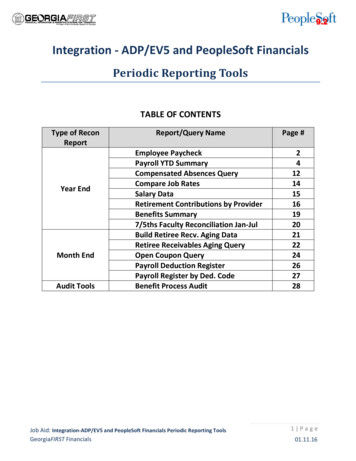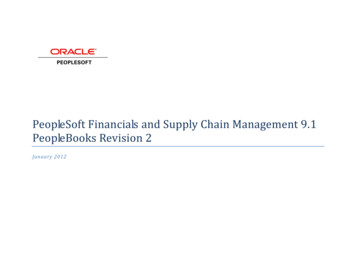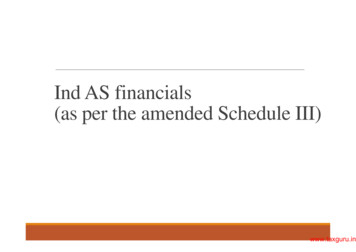
Transcription
Ind AS financials(as per the amended Schedule III)www.taxguru.in
IntroductionWith the applicability of the new Ind AS on certain class ofCompanies, it was evident that there was now a need for anamendment to the Schedule III of The Companies Act, 2013.With the change right there and the Ind ASs nowcommenced in their entirety, it is time to understand whatthe new financial statements (under Ind AS) actually presentand imply.www.taxguru.in
Ind AS Financial StatementsThe MCA on 6 April 2016, amended Schedule III to include general instructionsfor preparation of financial statements of a company whose financial statementsare required to comply with Ind AS.Ind AS 1 as well as the Act defines a “Complete Set Of Financial Statements” asfollows:Complete set of financial statementsBalance SheetStatement of profitand lossProfit or Loss SectionStatement ofchanges in equityCash FlowStatementNotesOther ComprehensiveIncomewww.taxguru.in
Phase IPhase IICompanies other than those covered under Phase IINBFCsNet worth 500 cr1stApril,2016Net worth 500 cr1stApril,2017 Net worth 250 cr 500 cr& All listed companies1stApril,20181stApril,2019 Net worth 250 cr 500 cr&All insurance Companiesand All listed companiesBanking CompaniesOnce applicable on a company, its holding, subsidiary, joint venture or associate companies shall also be required to applythe Ind AS from the same period.www.taxguru.in
Idea behind Ind ASs and its FinancialsObjectives of adoption (or convergence) Presentation at fair value. Recognition of time value of money. Making the financials shock proof (byrecognizing uncertainties timely (in theform of provisions) and increaseddisclosures).Let us better understand this through an example.www.taxguru.in
Example: Ind AS 16, Property, Plant and Equipments, inter alia, requires Valuation of assets at fair value (or optionally at cost), Recognition of estimated Asset Retirement Obligation (ARO) as part of cost ofasset, Measuring the supra at the discounted value.Objectives achieved:Valuation Recognition of costsinvolved with assetacquisitiontodayitself ARO recognized at PV Recognitionofimputed interest costof such provisionTime Value ofMoneyInd AS FairvalueaccountingRecognizingARO Morestaunchproponentof“True & FairDisclosure”www.taxguru.in
Key Areas of lidationTaxesRevenueRecognitionwww.taxguru.in
DIVISION II*of the Schedule IIIto the Companies Act, 2013*Division I contains the for Financial Statements applicable to those companies who are required to prepare their financials as per theexistingAccounting Standards.www.taxguru.in
PART I –BALANCE SHEETwww.taxguru.in
ParticularsIn accordance with the minimum disclosurerequirements under Ind AS 1(1)(2)NoteNo.ASSETSNon-current assets(a) Property, Plant and Equipment(b) Capital work-in-progress(c) Investment Property(d) Goodwill(e) Other Intangible assets(f) Intangible assets under development(g) Biological Assets other than bearer plants(h) Financial Assets(i) Investments(ii) Trade receivables(iii) Loans(iv) Others (to be specified)(i) Deferred tax assets (net)(j) Other non-current assetsCurrent assets(a) Inventories(b) Financial Assets(i) Investments(ii) Trade receivables(iii) Cash and cash equivalents(iv) Bank balances other than (iii) above(v) Loans(vi) Others (to be specified)(c) Current Tax Assets (Net)(d) Other current assetsFigures as at the endofcurrent reportingPeriodFigures as at the endof the previousreporting periodRenamedChange innomenclatureNew headingNew entryTotal Assetswww.taxguru.in
ParticularsNoteNo.Figures as at the endofcurrent reportingPeriodFigures as at the endof the previousreporting periodEQUITY AND LIABILITIESEquity(a) Equity Share capital(b) Other EquityIn accordance with the minimumdisclosure requirements under Ind AS 1(1)(2)RenamedLIABILITIESNon-current liabilities(a) Financial Liabilities(i) Borrowings(ii) Trade payables(iii) Other financial liabilities (other than thosespecified initem (b), to be specified)(b) Provisions(c) Deferred tax liabilities (Net)(d) Other non-current liabilitiesChange innomenclatureCurrent liabilities(a) Financial Liabilities(i) Borrowings(ii) Trade payables(iii) Other financial liabilities (other than thosespecified in item (c))(b) Other current liabilities(c) Provisions(d) Current tax liabilities (Net)New entryNew headingTotal Equity and Liabilitieswww.taxguru.in
Ind AS Balance SheetAn Ind AS balance sheet starts with disclosures of Assets, followed bydisclosures of Equity & Liabilities. The following is a summary of the keychanges vis-a-vis an IGAAP balance sheet:S.No.ChangeReason1.Removal of the head “Fixedassets” (comprised of tangibleand intangible assets).Elimination of nomenclature mismatchbetween the balance sheet and the AS.2.“Tangible assets” renamed as“Property, Plant andEquipment”. In line with the name of the new AS. Elimination of mismatch of namingconvention between the balance sheetand the AS.3.Introduction of a separate head“Investment Property”.Introduction of separate Ind AS onInvestment Properties.www.taxguru.in
S.No.ChangeReason4.Disclosureof“Goodwill” In line with presentation under sure of “Biological Assets Introduction of separate Ind AS onother than bearer plants” Agriculture.separately.6.Introduction of new“Financial Assets”.7.Clubbing of Investments, Trade Coverage of all such items clubbed underreceivables, Loans, Cash and a single set of Ind AS on Financialcash equivalents, etc. under the Instruments.head “Financial Assets”.8.Disclosure of “Current Tax As per the requirement of Ind AS 12,Assets (Net)” on the face of the “Income Taxes”.Balance Sheet.9.“Share Capital” renamed as Since Share Capital now comprises of“Equity Share capital”.only equity share capital.heads Introduction of separate Ind AS onFinancial Instruments.www.taxguru.in
S.No. ChangeReason10.“Reserves and Surplus” now Inclusion of new components like Equityreplaced with “Other Equity”.component of Compound FinancialInstruments and merger of other headslike Share Application Pending Allotment. Introduction of the new concept of OCI.11.Introduction of new“Financial Liabilities”.12.Clubbing of Borrowings, Trade Coverage of all such items clubbed under apayables etc. under the head single set of Ind AS on Financial Instruments.“Financial Liabilities”.13.Disclosureof“CurrentTax As per the requirement of Ind AS 12, “IncomeLiabilities (Net)” on the face of the Taxes”.Balance Sheet.14.Bank deposits maturing after morethan 12 months to be shown under“Other Financial Assets” instead of“Cash and Cash Equivalents”.heads Introduction of separate Ind AS on FinancialInstruments.Classifying such bank deposits under Cashand Cash Equivalents led to such assets beingclassified under Current Assets rather thanNon Current.www.taxguru.in
Impact of Ind AS on Balance SheetAccountingDeferred tax to be recognized usingBalance sheet approach.Accounting for M&As using fairvalue approach.Movement in ratios e.g. Debt EquityRatio, Interest Coverage Ratios etc.RecognitionLong term provisions to becarried on present value.Assets to include Asset retirement obligation onpresent value basis.Investments to be recognizedat fair value only.PresentationReclassification of financial instruments Convertible bond as equity andredeemable pref. share as debt.ESOP Trusts to be consolidated.Provisions to be recognized andcarried at discounted values.www.taxguru.in
Detailed discussion on the majorchanges in the Balance Sheetwww.taxguru.in
Fixed Assets The heading “Fixed Assets”, under which the Tangible andIntangible Assets were grouped caused a nomenclaturemismatch between the Accounting Standards and the BalanceSheet, since the AS name Fixed Asset, i.e. AS 10 covered onlyTangibles while Intangibles were covered under AS 26.Property, Plant and Equipment Classification to be given in the similar manner as was givenunder the existing standards, i.e. Land, Buildings, Plant andEquipment, etc. with a reconciliation for each class of assets.www.taxguru.in
Investment Property As per Ind AS 40, Investment Property, an Investment Property hasbeen defined as a land or building (or part thereof) held to earncapital appreciation or rental or both. Under the existing structure, such assets were governed by AS 13and thus disclosed under the head Investments itself. Only COST model is applicable for valuation of Investment Properties.Financial Assets* and grouping of assets under it Under the AS regime, ASs on Financial Instruments (AS 31, 31, 32)were not mandatory and thus could not carved into the standardformat of a Balance Sheet. Since Ind AS contain separate guidance in this regard and on thelines of IFRS, the head Financial Assets was introduced in theBalance Sheet. Consequently, all assets (specifically Investments, Trade Receivables,Cash, etc.) under the definition (detailed on the next page) ofFinancial Assets were clubbed under this major head.* Explained and defined on the next slidewww.taxguru.in
Financial AssetCashEquity instrumentsE.g. Shares in acompany whetherlisted or unlistedsharesContractual rightsContractual to besettled in entity’sown equityinstrumentsTo receive anotherfinancialasset(includescash,equity shares etc.)ORTo exchange afinancial asset orliability to onesown advantageDerivativesORNon - DerivativesE.g. Debt instruments,debt portion of compoundfinancial instruments (likepreferenceshares,convertible bonds)www.taxguru.in
Shareholder’s fund Renamed as Equity. Comprises Equity Share Capital and other equity instead ofShare Capital and Reserves and Surplus. Only that portion of capital which indicates residual interest inthe entity is classified under Share Capital and thus preferenceshares are excluded (except for its equity component). Reserves and Surplus, inter alia, includes Equity Component ofCompound Financial Instruments.Other changes on the liabilities side Corresponding effects of that on the assets side have beenbrought on the liabilities side as well.www.taxguru.in
STATEMENT OF CHANGES INEQUITYwww.taxguru.in
Statement of Changes in EquityThe Statement Of Changes In Equity has been introduced on the lines of IFRS. AnSOCE is prepared in order to reconcile the various components of equity in thebalance sheet for any period.The 2 divisions created herein are the analysis of “Equity” in the Balance Sheet. Itcan also be said to an Analysis of Change in Net Worth of an Entity.Comparative Figures in an SOCE:Due to the extensive format of an SOCE, it is not possible to present the comparative figuresin vertical format. Thus the comparatives may be presented either before or after the SOCEfor the current year as is presently done by preparers of IFRS financials.www.taxguru.in
A. Equity Share CapitalBalance at the beginning of thereporting periodChanges in equity sharecapital duringthe yearBalance at the end of thereporting periodB. Other EquityReflects the change in the fairvalue of the Equity Instrumentswhere FVTOCI* is opted for.Earlier, appeared as aseparate entry in theBalance SheetShareapplicationmoneypendingallotmentBalance atthebeginning ofthereportingperiodChanges inaccountingpolicy or priorperiod errorsEquitycomponent ofcompoundfinancialinstrumentsReserves and Reserves(specifyNature)The most significant ePreferenceShares and Debentures.*FVTOCI – Fair value Through Other Comprehensive prehensiveIncomeEffectiveportionof sontranslatingthefinancialstatementsof aforeignoperationOtheritemsof edagainstsharewarrantsTotalReflects the change in thefair value of the DebtInstruments is required tobe valued at FVTOCI*.www.taxguru.in
Restatedbalance atthebeginningof thereportingperiodTotalComprehensiveIncome for theyearDividendsTransfer toretainedearningsAny otherchange (to bespecified)TotalComprehensiveIncome for theyearDividendsTransfer toretainedearningsAny otherchange (to bespecified)Balance at theend of thereporting periodwww.taxguru.in
PART II –STATEMENT OFPROFIT AND LOSSwww.taxguru.in
ParticularsIRevenue From OperationsIIOther IncomeIIIExpenses classified on thebasis of Nature of ExpensesNoteNo.IVFigures as at theend ofcurrent reportingPeriodFigures as at theendof the previousreporting periodTotal Income (I II)EXPENSESCost of materials consumedPurchases of Stock-in-TradeChanges in inventories of finished goods,Stock-in -Trade and work-in-progressEmployee benefits expenseFinance costsDepreciation and amortization expenseOther expensesTotal expenses (IV)VProfit/(loss) before exceptional items andtax (I- IV)VIExceptional ItemsVIIProfit/(loss) before tax(V-VI)VIIITax expense:(1) Current tax(2) Deferred taxIXProfit (Loss) for the period fromcontinuing operations (VII-VIII)XProfit/(loss) from discontinued operationsRenamedwww.taxguru.in
In accordance with therequirements of Ind AS 33, EPSIn accordance with therequirements of Ind AS 1ParticularsXITax expense of discontinued operationsXIIProfit/(loss) from Discontinued operations(after tax) (X-XI)XIIIProfit/(loss) for the period (IX XII)XIVOther Comprehensive IncomeA (i) Items that will not be reclassified toprofit or loss(ii) Income tax relating to items that willnot be reclassified to profit or lossB (i) Items that will be reclassified toprofit or loss(ii) Income tax relating to items that willbe reclassified to profit or lossXVTotal Comprehensive Income for the period(XIII XIV)(Comprising Profit (Loss) andOther Comprehensive Income for theperiod)XVIEarnings per equity share (for continuingoperation):(1) Basic(2) DilutedXVIIEarnings per equity share (for discontinuedoperation):(1) Basic(2) DilutedXVIIIEarnings per equity share(for discontinued& continuing operations)(1) Basic(2) DilutedNoteNo.Figures as at theend of thecurrent reportingPeriodFigures as at theendof the previousreporting periodRenamedNew entrywww.taxguru.in
Ind AS Statement of Profit and LossAn Ind AS P&L consists of 2 section the Profit and Loss and the OCI (otherComprehensive Income). The following is a summary of the key changes vis-a-vis anIGAAP balance sheet:S.No.ChangeReason1.Removal of “extra-ordinaryitems” from the SPL.Ind AS 1 strictly prohibits disclosure of anitem as an extra-ordinary item.2.“Discontinued operations”instead of “DiscontinuingOperations”.Due to change in the scope of therelevant Ind AS vis-à-vis the AS.3.Insertion of “OtherComprehensive Income”.Covered in detail in the sections to follow.4.Disclosure of EPS for continuingoperation and discontinuingoperation .Additional disclosure requirements.www.taxguru.in
Other Comprehensive Income (OCI)At outset, it is worthwhile to note that Total Comprehensive Income is differentfrom Other Comprehensive Income and can be better understood as follows:Profit(loss) forthe periodOCITCIWhat is OCI? Ind AS 1 defines it as “comprising of items of income andexpense (including reclassification adjustments) that are notrecognized in profit or loss as required or permitted by otherInd ASs.Why OCI? Providing cushion to the Profits. Reflecting notional gains and losses outside the profit(loss). A barometer for upcoming threats or windfalls to net income(as it contains profit/loss on change in fair value for certainitems).www.taxguru.in
Illustrative items in OCIItems in OCIDescriptionChanges in revaluation surplus Ind AS 16, Property, Plant and Equipment and Ind AS 38,Intangible Assets provide an option to choose theRevaluation Model and where chosen, any upwardrevaluation is recognised in OCI.Re-measurements of defined benefit plansActuarial gains and losses are to be recognised in OCI.Gains and losses arising from translating In the case of standalone financial statements, a foreignthe financial statements of a foreignoperation refers to a branchoperation In the case of consolidated financial statements, foreignoperation refers to a subsidiary, a JV or an associate.Gains and losses from investments in Ind AS 109, Financial Instruments provides an option and inequity instruments designated at fair value certain cases, require that changes in the fair value of equity(or other financial assets measured at FV)instruments be recognised in the OCI.Reclassification adjustmentsAmounts reclassified to 'profit or loss' in the current periodthat were recognised in 'other comprehensive income' in thecurrent or previous periods.www.taxguru.in
Impact of Ind AS on Statement ofProfit and LossAccountingDividend on redeemable preference share to berecognized as interest costIntangibles can have an indefinite useful life andtherefore change in amortization charge.RecognitionTiming of revenuerecognition.Revenues on multiples component contractsrecognized separately.Revenue to be reported ongross basis net of incentivesand discountsPresentationActuarial gain/loss recognizedthrough OCI.Joint Ventures will be consolidatedby equity method only, impactingEBITDA.Indirect taxes paid to form part ofcost line items.www.taxguru.in
Cash Flow StatementAlike under the IGAAP, Schedule III for Ind AS does not provide for aformat of the Cash Flow Statement and requires that the statement beprepared in accordance with the relevant Ind AS.However, in a sharp contrast to the AS 3 on Cash Flow Statements, IndAS 7 on Cash Flow Statements “encourages” the use of Direct Methodinstead of the Indirect Method for preparing the Cash Flow Statementsbut provides no format for the preparation of the same.www.taxguru.in
Other requirements i.r.o. the IndAS Financial Statementswww.taxguru.in
Other requirements i.r.o. Ind AS FinancialsMaterialityDefinedMateriality inSPLThird BalanceSheetProposeddividend Financial statements to disclose all ‘material’items. Items are material if they could, individually or collectively, influence the economic decisionsthat users make on the basis of financial statements. Disclose separately any item of income or expenditure which exceeds: 1 % of the revenue from operations or INR 10,00,000 whichever is higher. A third Balance Sheet to be prepared and presented where any item has been retrospectivelyrestated. In a sharp contrast to AS, Proposed Dividend cannot be recognised in the SPL if it has beenproposed after the date of the Financials. However, the disclosure for the same shall be given in the notes to accounts.www.taxguru.in
xguru.in
Ind ASInd AS 101 : First-time Adoption of Indian AccountingStandardsInd AS 102 : Share-based PaymentInd AS 103 : Business CombinationsInd AS 104 : Insurance ContractsInd AS 105 : Non-current Assets Held for Sale andDiscontinued OperationsInd AS 106 : Exploration for and Evaluation of MineralResourcesInd AS 107 : Financial Instruments: DisclosuresInd AS 108 : Operating SegmentsInd AS 109 : Financial InstrumentsInd AS 110 : Consolidated Financial StatementsInd AS 111 : Joint ArrangementsInd AS 112 : Disclosure of Interests in Other EntitiesInd AS 113 : Fair Value MeasurementInd AS 114 : Regulatory Deferral AccountsAccounting StandardsNo corresponding ASNo corresponding AS but, GN on accounting foremployee Share-based PaymentAS 14 : Accounting for amalgamationsNo corresponding ASAS 24 : Discontinuing OperationsNo corresponding AS but, GN on accounting for oil andgas producing companiesAS 32 : Financial Instruments: DisclosuresAS 17 : Segment reportingAS 13 : Accounting for investmentsAS 30 : Financial Instruments: Recognition andMeasurementAS 21 : Consolidated Financial StatementsAS 27 : Financial Reporting of Interests in Joint VenturesNo corresponding ASNo corresponding ASNo corresponding ASwww.taxguru.in
Ind ASInd AS 1 : Presentation of Financial StatementsInd AS 2 : InventoriesInd AS 7 : Statement of Cash FlowsInd AS 8 : Accounting Policies, Changes in AccountingEstimates and ErrorsInd AS 10 : Events after the Reporting PeriodInd AS 11 : Construction ContractsInd AS 12 : Income TaxesInd AS 16 : Property, Plant and EquipmentInd AS 17 : LeasesInd AS 18 : RevenueInd AS 19 : Employee BenefitsInd AS 20 : Accounting for Government Grants andDisclosure of Government AssistanceInd AS 21 : The Effects of Changes in Foreign ExchangeRatesInd AS 23 : Borrowing CostsInd AS 24 : Related Party DisclosuresInd AS 27 : Separate Financial StatementsInd AS 28 : Investments in Associates and JointVenturesAccounting StandardsAS 1 : Disclosure of accounting policiesAS 5 : Net P/L, PPI and Change in estimatesAS 2 : Valuation of InventoriesAS 3 : Cash Flows StatementAS 5 : Net P/L, PPI and Change in estimatesAS 4 : Contingencies and events occurringafter balance sheet dateAS 7 : Construction ContractsAS 22 : Accounting for income TaxesAS 6 : DepreciationAS 10 : Accounting for fixed assetsAS 19 : LeasesAS 9 : Revenue RecognitionAS 15 : Employee BenefitsAS 12 : Accounting for government grantsAS 11 : The Effects of Changes in Foreign ExchangeRatesAS 16 : Borrowing CostsAS 18 : Related Party DisclosuresAS 21 : Consolidated Financial StatementsAS 23 : Accounting for Investments in Associates inConso Fin Statementswww.taxguru.in
Ind ASAccounting StandardsInd AS 29 : Financial Reporting in HyperinflationaryEconomiesNo corresponding ASInd AS 32 : Financial Instruments: PresentationAS 31 : Financial Instruments: PresentationInd AS 33 : Earnings per ShareAS 20 : Earnings per ShareInd AS 34 : Interim Financial ReportingAS 25 : Interim Financial ReportingInd AS 36 : Impairment of AssetsAS 28 : Impairment of AssetsAS 26 : Intangible AssetsInd AS 37 : Provisions, Contingent Liabilities andContingent AssetsAS 29 : Provisions, Contingent Liabilities andContingent AssetsInd AS 38 : Intangible AssetsAS 26 : Intangible AssetsInd AS 40 : Investment PropertyAS 13 : Accounting for investmentsInd AS 41 : AgricultureNo corresponding ASwww.taxguru.in
In continuation of the earlier series of “InteractiveLearning on Ind AS”, here is yet another boastfulattempt to educate on the further dynamism in theReporting segment, viz. amendment in Schedule III ofthe Companies Act, 2013 whereby Ind AS FinancialStatements have been laid down.Ind AS still remains a vast less explored area and ourendeavour to disseminate on the topic continues Stay tuned for more.Happy Reading to you !!READ, LIKE AND SHARE!!!!Prepared by: Nitish AggarwalWould like to hear from you:e-mail: nitishaggarwal7@gmail.comwww.taxguru.in
1. Removal of the head “Fixed Elimination of nomenclature mismatch assets”(comprised of tangible and intangible assets). between the balance sheet and the AS. 2. “Tangible assets”renamed as “Property, Plant and Equipment”. In line with the name of the new AS. Elimination



